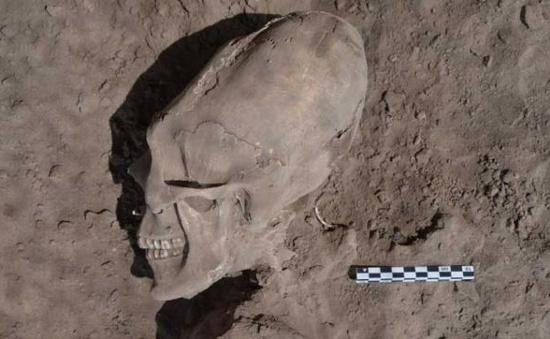10 most archeological discoveries (1)
Each archaeological discovery contains a lot of surprises, even bizarre, from the alien skull to the book of Death.
>>>10 most archeological findings (2)
History has always covered the mystery. It is the archaeological findings that reveal the rare light of the world of the ancients, the period of human ancestors. They are more vivid and informative materials than any historical textbook.
Here is a list of the 10 'most heterogeneous' archaeological findings :
Alien skull in Mexico
In December 2012, dozen firefighters discovered in a mass grave in the village of Onavas, northern Mexico. Of the 25 bodies discovered, 13 skulls are bizarre shapes that are similar to those depicting aliens.
Although there are many speculations of people that this is an alien, scientists deny this and said that the shape of the skulls dating to about 1,000 years old looks elongated due to being compressed. religious practices.

Is this alien skull?
Specifically, in ancient Mesoaameria culture, custom of deforming skulls aimed at distinguishing different social classes.
Adults use straight wooden sticks to squeeze the heads of 1-month-old babies, creating pressure for the skull to grow upwards for about 6 months and has an oddly elongated shape. Many children do not capture the head brace may have died early.
Blood of King Louis XVI
In 1793, King Lousi XVI of France was decapitated by revolutionary forces. Legend has it that when the 39-year-old king fell, many witnesses pulled back and dipped their handkerchiefs into the blood.
The story became a reality when scientists discovered a dry gourd shell with a blood-stained handkerchief of this king.

The wine has blood on Louis XVI.
However, DNA test results are not valid when there is no other DNA sample to compare. However, one scientist once studied the stolen head of King Hery IV, the seven-year-old of King Louis XVI assassinated in 1610, completed the hypothesis when he produced the DNA of this head. .
Otzi who ice
After thoroughly studying the blood samples of Otzi people, German and Italiana scientists discovered that the blood of this dried corpse was perfectly preserved during the 5,300 years.
Using atomic force microscopes, they examined the maternal blood cells of the mummy and concluded that they had the same characteristics as modern human blood.

Otzi tapes were discovered by two German climbers.
In 1991, two German climbers discovered the bodies of Otzi ice in the Oetz valley, the Alps, north of Italya. Through research, scientists can discover a lot of events related to it: the ice is about 1.6 meters tall, weighs 50 kg and dies at about 45 years old. When alive, Otzi was infected with intestinal parasites which prevented him from absorbing lactoze and became ill 3 times in the last 6 months of his life.
However, it is likely that Otzi died due to being hunted in the mountains and hit a fatal arrow through the center of his chest and left shoulder. Another study pointed out that, after winning the name, the iceman did not die immediately but moved to the place where his body was discovered.
Giant cemetery of koalas
Australian scientists have just discovered the largest ever graveyard of the extinct giant tiger. If the modern koalas are the cutest animals on earth, their ancestors are like a nightmare.

The ancestors of koalas are really "ugly".
The koalas, whose scientific name is Diprotodon, has the depleted shape of a combined rhino and grizzly bear. Weighing about 2.8 tons, they are the largest marsupial ever, appearing two million years ago and extinct at the same time as humans and climate change. The chest pocket can hold an adult.
Human brain is 2,600 years old
In April 2012, a brain embedded in the skull of an Iron Age prehistoric man was discovered in a flooded pit in Heslington, Yorshire, UK. This person was hanged and then beheaded. According to scientists, the area of human skull detection is also the place to perform rituals from the Bronze Age to the early Roman period.

Human brain is 2,600 years old.
Preserved in rare-gas liquid solvents to protect brain tissue, the scientists determined the skull was 2,684 years old and was 'well-preserved'. Because, in the air, despite the cold of the hospital morgue, brain tissue decomposes very quickly before the muscles and other soft tissues decompose.
Scientists assume, perhaps after being killed, the man's head falls into a water hole, the wet environment is the perfect condition to keep the brain 'fresh' by special chemicals in brain tissue, while Other parts of the body have decomposed quickly.
- 10 most archeological findings (2)
- 5 terrifying archaeological discoveries related to human sacrifices
- 10 forgotten archaeological discoveries have been found again
- 10 outstanding scientific discoveries in 2008
- New discovery about Bach Dang and Van Don relics
- Strange story surrounding an ancient burial area
- New discoveries about the human body (Part 2)
- 5 most outstanding scientific discoveries in 2013
- 4 new discoveries about love that amaze you
- New discoveries about animals
- Sex and interesting scientific discoveries
- 9 discoveries about us in 2009
 Discovered an ancient centipede fossil 99 million years old
Discovered an ancient centipede fossil 99 million years old Discovered bat-like dinosaurs in China
Discovered bat-like dinosaurs in China Discovered a 200-year-old bronze cannon of the coast
Discovered a 200-year-old bronze cannon of the coast Discover 305 million-year-old spider fossils
Discover 305 million-year-old spider fossils